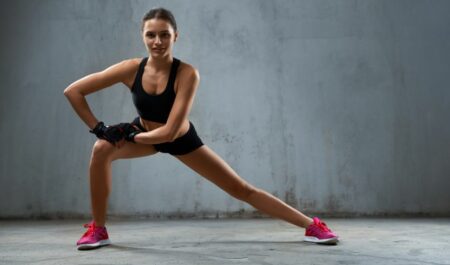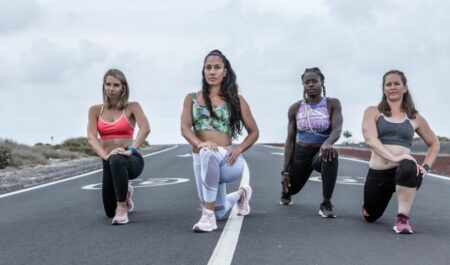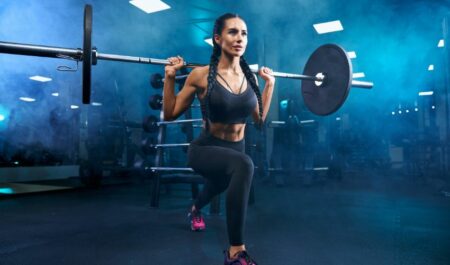One of the most common exercises for building stronger legs is the lunge, which can be performed in a wide number of ways to keep your routine interesting. Altering the manner in which you perform the exercise enables you to place more emphasis on various muscles or portions of those muscles. Because of that, this article is going to explorer about what muscles do lunges work , how to do and what are the variations of lunges workouts.
This activity is helpful for both the prevention of injuries and the rehabilitation of those who have already suffered them. It is frequently included in a fundamental strength program or a rehab protocol, which enables athletes and exercisers to return to their sport or activity of interest as soon as is physically possible.
The lunge is another form of functional exercise that gets you ready for the kinds of motions you’ll encounter in everyday life.

It is a common position that people assume when they get up from the ground, and it mimics many of the movements and patterns of muscle activation that occur during daily activities, such as walking and running and climbing or descending stairs. For instance, it is a position that people assume when they get up from the ground.
One single repetition of this powerhouse motion engages a significant number of the muscles in the lower body. It is simple to carry out and comes with a myriad of advantages. In the following paragraphs, we will go over these aspects, as well as modifications that can be used to vary the level of difficulty and target specific muscles.
Which Muscles Do You Target When You Perform A Lunge?
A lunge engages a large number of muscles, which helps to mobilize and stabilize the body. They are as follows:
- The quadriceps.
- The gluteals.
- The muscles of the hamstrings.
- The calves (gastrocnemius and soleus).
- The transverse abdominis muscle.
- The obliques.
- The multifidus
- The erector spinae muscle group
During a lunge, the muscles of the lower body, particularly the quads, glutes, and hamstrings, work in both a concentric (shortening) and eccentric (lengthening) manner.
The forward lunge is the most fundamental form of the lunge exercise. It consists of taking one step forward, bringing your body down until it is parallel to the ground, and then returning to the beginning position. When most people talk about “doing lunges,” they are referring to this particular kind of the exercise.
Your calf muscles will need to work hard at the beginning of the exercise to keep the impact of your foot landing under control. The next portion of the action is known as the eccentric phase, and it consists of bringing your body closer and closer to the ground.
To maintain control over the movement, your muscles will begin to stretch while they are under strain during this phase. The quadriceps are responsible for slowing down your landing, and they collaborate with the hamstrings and gluteals to maintain complete control of the descent.
Studies have demonstrated that the glute and hamstring muscles in the front leg are working a little bit harder than those in the back leg, even if all of the muscles in both the front and back legs are working eccentrically.
During the step-back phase of the forward lunge, you will be performing a dynamic push back to the starting position. When the body is brought back into an upright position, the same muscles contract with great force. Because the muscles are shortening (contracting) in order to move the body, this stage of the movement is referred to as the concentric phase.
Lunges are one of the most efficient exercises because they force the body to exert effort during the eccentric part of the movement. According to the findings of several studies, eccentric muscle contraction is superior to concentric muscle contraction in terms of its ability to increase muscular size and hypertrophy.
What Are The Advantages Of Performing Lunges?
Lunges provide various benefits. The fact that they work multiple muscle groups in the lower body at the same time is the most important advantage. Therefore, they are a key exercise in many different strengthening and injury prevention programs, such as the program for the prevention of injuries to the anterior cruciate ligament (ACL).
Because of the greater demand placed on the front leg during a lunge than on the back leg, this exercise is classified as a unilateral movement.
In comparison to exercises such as squats, for example, this one enables you to enhance uneven strengths more effectively. Lunges are great for improving your balance and stability in unilateral movements since they present a challenge.
The mechanics of the lunge are quite similar to those of running, making it an excellent workout for runners. The initial step out and the landing are quite similar to the actions that occur during a running stride; however, the body does not experience the significant ground response force that occurs while running.
Because of this, the lunge is an excellent exercise for building stronger muscles, which can then be used to absorb the impact of movements that are performed at a higher intensity. Lunges, particularly walking or leaping forms of the exercise, were found to be quite helpful at training younger athletes in an older research study.
In addition, the lunge works opposing leg muscles at the same time, making it a very efficient exercise. A resistance training program may benefit from enhanced effectiveness as a result of this.
If you only have time for a few exercises, it is best to integrate activities that train numerous joints at the same time. This will maximize the benefits of your workout.
How To Properly Perform A Lunge.
To begin, get into a standing stance and place your feet approximately hip-width apart.
Take a step that is little longer than normal forward such that one of your legs is in front of your chest and the other is behind it. Your foot should land flat, and when it is on the ground, it should stay in that level position. Your back heel will come up off of the ground when you do this.
As you lower yourself, your knees should be bent to a position that is roughly 90 degrees. It is important to remember to keep your back straight and your core engaged.
The next step is to return to the starting position by kicking off your front leg with a lot of force.
Remember These Important Points:
- As you move closer to the ground, your front knee shouldn’t move further forward than your toes.
- It is important that your back knee does not make contact with the ground.
- Your goal should be to maintain symmetry in your hips (at the same height, without dropping the hip of your back leg or hiking the hip of your front leg).
- Keeping your abdominal muscles contracted throughout the exercise will assist you in keeping your trunk upright.
- During the landing and the return, keep the distance between your feet hip-width apart.
Different Takes On The Lunge (And When To Use Each).
The lunge can be performed in a number of different ways. Each one engages the same muscles, yet some parts of the body receive a greater workout than others do. You can add diversity and difficulty to your workout by performing a different version each time, or you can combine multiple variations to achieve the same effect.
1. Static lunge.

The static lunge, commonly referred to as the split squat, does not need the performer to take either the step out or the step back. Those who experience knee pain, or those who are just starting out with lunging exercises, may find it easier to complete this exercise.
In the same way that the forward lunge places an emphasis on the medial and lateral quadriceps, this exercise does the same thing.
The Proper Way To Doing Static Lunge:
- Maintain a split stance by placing one foot in front of the other while standing with your feet hip-width apart from one another. You won’t have any contact with the ground with your back heel.
- Bending your knees to a right angle of ninety degrees will allow you to lower yourself toward the ground.
- The movement should start from the glutes, and then the quadriceps should be activated to straighten the knee, push into both feet, and return to the upright posture.
- Perform this exercise as a jumping lunge to up its difficulty level to that of an expert plyometric move. When you are at the bottom of the lunge, explode off of both feet, switch your feet while you are in the air, and land in a lunge with the opposite foot in front.
- Because jumping lunges are so challenging, you should check with a fitness professional before doing them if you are doubtful of their suitability.
2. Back Lunge.
The only difference between the forward-stepping lunge and the back lunge is that the back foot is the one that moves during the back lunge.
As a result of the exercise being performed in a backward motion through space, there is a decreased stress placed on the quadriceps muscles and a greater emphasis placed on the gluteals and hamstrings. As a result, the knee is subjected to a lesser amount of impact.
How to Do Back Lunge Properly?
- To begin, get into a standing stance and place your feet approximately hip-width apart.
- Take a step backward that is far longer than a normal walking stride such that one of your legs is always in front of your chest and the other is always behind it. Your rear foot ought to touch down on the ball of the foot, and you should keep your heel raised.
- As you lower yourself, your knees should be bent to a position that is roughly 90 degrees. It is imperative that you remember to keep your back straight and your hips level.
- To go back to the starting position, you should start by giving a strong push off from the ball of the rear foot.
3. Lateral Lunge.

The lateral lunge requires the athlete to take a step to the side rather than forward or backward. This version of the lunge engages the adductor muscles, which are located on the inside of the groin, more than the other types of lunges do. This is due to the lateral movement pattern. Additionally, it places an emphasis on the medial quadriceps.
How To Do Lateral Lunge?
- Take a standing position with your feet about hip-width apart.
- While maintaining a flat foot with your other foot, take a broad step to the side.
- While you step, bend the knee that will be supporting your weight and keep the other knee straight. In comparison to forward and backward lunges, your torso will tilt forward somewhat, and your shoulders will be slightly in front of your knees while you perform lunges sideways.
- To go back to the beginning position, you should push off from your foot with all of your might.
4. Curtsy Lunge.

The curtsy lunge is an excellent exercise that places additional attention on the gluteus medius and the hip adductors (or inner thighs).
Throughout the entirety of this exercise, the gluteus medius works to maintain your pelvis while you lunge in a posture with your legs crossed, and the adductors work to keep your legs in that position while you lower yourself down.
What Is The Way Of Doing Curtsy Lunge?
- Take a standing position with your feet about hip-width apart.
- Cross your legs by putting one foot behind the other and stepping out to the side. This will complete the motion. When you put weight on your front foot, the heel of your back foot will rise off of the ground.
- You should bend both of your knees and lower yourself till the front of your thigh is parallel to the floor. Maintain an uplifted chest, an engaged core, and knees that move directly over the toes throughout the exercise.
- While simultaneously lifting your rear foot to bring it back to a hip-width, parallel stance, you can straighten both of your knees by applying pressure to your legs, particularly the front leg.
- If you are having trouble maintaining your balance, try switching legs and alternating as you go, or just stand on one leg at a time. Be careful to perform an equal number of reps on both the left and right sides.
5. Walking Lunge.

Exercise is more common to perform the walking lunge while going forward (as it is detailed below), but you may also perform it while walking backward. The gluteal muscles, medial quadriceps, and hamstring muscles all receive additional attention as a result of this.
How To Do Walking Lung?
- Take a standing position with your feet about hip-width apart.
- Take one step forward and bend both knees, lowering yourself till the angle formed by your knees when bent is 90 degrees.
- Move forward onto the front leg, which is the lead.
- You will begin in a lunge posture by putting pressure on both of your legs, stepping through, then lifting your back leg and moving it forward so that it rests in front of you.
- Continue moving forward and do it once more.
One way to modify the walking lunge is to lunge forward as if you were going to step through with the rear foot. However, instead of stepping through with the rear foot, you should step it forward so that it lands parallel to the lead foot, and then straighten both legs. This places you back in the position you were in before. After that, you should switch feet and walk forward with the other one each time.
The version in which you step through is more difficult and requires more balance than this alternative, which is simpler and easier.
Including Weight With Your Lunges And Squats.

If you are going to add weight, you should begin with a weight that is lower than what you would normally use for a squat or deadlift. When completing a lunge that requires moving out away from your center of gravity, this is the most critical consideration to make.
There are a few different ways that you might pack on the pounds. You are capable of holding both dumbbells. Alternately, you can perform the lunge in the same manner as you would a barbell squat by carrying the weight on your shoulders. To maintain stability, your back extensors and core muscles will have to work harder than usual.
Alternately, you might grip one dumbbell in the hand that is not supporting your lead leg while you lunge. This places an emphasis not just on the oblique muscles, which help to maintain the trunk, but also on the upper gluteal muscles.
The conclusion
The lunge is a fantastic exercise for working the muscles of the lower body, especially the quadriceps and hamstrings. It provides a number of different versions, each of which focuses on a different muscle group, such as the glutes, quadriceps, or hamstrings. You can adjust the difficulty of the exercise based on your level of experience using the variants that are provided.
Include this activity in your workout routine, and have fun experimenting with different variants to keep things interesting.
